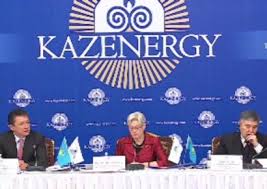 ASTANA – The 15th session of the KazEnergy council under the chairmanship of Timur Kulibayev took place on Jan. 16 in Astana. The council is an advisory body in which the largest Kazakh and foreign companies operating in Kazakhstan’s energy sector participate.
ASTANA – The 15th session of the KazEnergy council under the chairmanship of Timur Kulibayev took place on Jan. 16 in Astana. The council is an advisory body in which the largest Kazakh and foreign companies operating in Kazakhstan’s energy sector participate.
Asset Issekeshev, Deputy Prime Minister and Minister of Industry and New Technologies; Uzakbay Karabalin, Minister of Oil and Gas; Nurlan Kapparov, Minister of Environment and Water Resources; Yerbolat Dossayev, Minister of Economy and Budget Planning participated in the session. Maria van der Hoeven, executive director of International Energy Agency (IEA), also attended. The head of the IEA presented the World Energy Outlook for 2013 as well as the forecast of the global energy development. According to van der Hoeven, Kazakhstan is a promising source of oil production growth.
During the session, the National Energy Report was presented. The presentation was prepared by KazEnergy. The report included key indicators in the energy balance which allows planning and future development of Kazakhstan’s oil and gas industry and the energy sector in general.
“According to our estimates, oil production will reach around two million barrels per day after 2020,” Karabalin said. According to the oil and gas minister, oil production has more than tripled to 1.6 million barrels per day, whereas natural gas production has more than quintupled and reached 40 billion cubic metres per year.
“It is important that according to forecasts for up to 2035, oil, gas and coal are still cited as the most significant global energy resources. The energy sector is key in supporting strategic tasks. Since independence, we have entered the top 15 countries possessing proven oil reserves and the top 20 countries possessing natural gas reserves,” Karabalin noted.
It was reported earlier that by the end of 2014, the volume of oil production will reach 83 million tonnes. Oil production data is based on the strategic plan of the Ministry of Oil and Gas for 2011-2015. During the period from January to August 2013, Kazakhstan produced 54 million tonnes of oil and condensate which exceeded 2012 levels by three percent.
At the Kashagan field, it is planned to produce around 15 million tonnes of oil in 2022. The share of KazMunayGas in this operation will reach 2.51 million tonnes. At the Tengiz field, production is expected to reach 39.315 million tonnes in 2022, including 7.863 million tonnes from KazMunayGas. The Karachaganak field is expected to produce 7.760 million tonnes; with the share for KazMunayGas of 776,000 tonnes. It was noted, however, that the data is subject to possible adjustment in the future.
Another major issue discussed during the session was emissions penalties related to the recent gas leaks at Kashagan. In September 2013, oil production at the field was suspended shortly after its start because several gas leaks were discovered in the pipelines from Island D to the onshore Bolashak Refinery.
Karabalin said: “The sanctions and fines specified in our agreement will be applied [to the consortium developing the field]. The size of the penalties will first of all depend on the ecological damage caused by the gas leaks and acid gas incineration. The process is under the jurisdiction of the Ministry of Environment. They have already conducted several meetings with the contractor to define the precise volume of gas incinerated, bled, etc.”
Referring to the pipeline examination process, Karabalin further added: “Data analysis is being finalized. We expect work to be completed by the end of the month. After that, the contractor will present a plan of restoration of the gas pipeline and the system in general.”
In general, the annual meeting provided a useful platform that allowed the discussion of current issues in Kazakhstan’s energy sector and its prospects in the current global energy climate.

